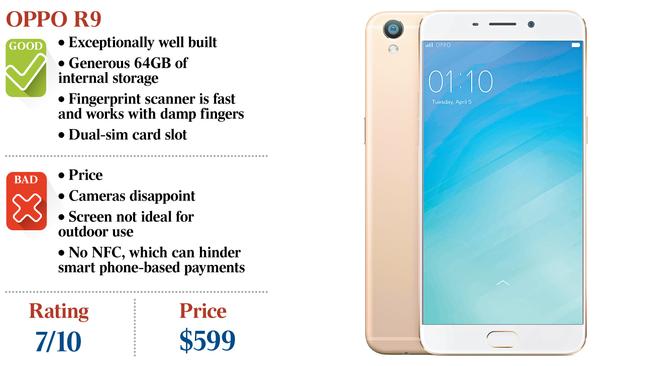Review: Oppo R9 — iPhone clone just misses the mark
No other Chinese handset maker has been more aggressive about breaking into the Australian market than Oppo.

Chinese smartphone players such as OnePlus and Xiaomi have been taking the fight up to the likes of Samsung and Apple with premium handsets at extremely affordable prices. However, outside of Huawei, no other Chinese handset maker has been more aggressive about breaking into the Australian market than Oppo.
Oppo is the world’s fifth-largest smartphone maker and has finally set its sights on Australia, securing a distribution deal with Optus and retail giant JB Hi-Fi.
The R9 (known as the F1 Plus in other markets) is easily the best phone Oppo has ever made, but is it worth the $599 sticker price?
The R9 offers a level of build quality normally reserved for top-tier flagships. Admittedly, it shares a lot of similarities with the iPhone from the eye-catching rose gold metallic design to the iOS-inspired Android software. However, Oppo has added some design improvements of its own. Despite housing a larger 5.5-inch display, the R9 is noticeably lighter and thinner than the iPhone 6s. The near edge-to-edge display means that the R9 is also more compact in the hand than the 5.5-inch iPhone 6s Plus.
The fingerprint scanner built into the home button of the R9 is the fastest we’ve ever tested, edging out the latest iPhone and Samsung Galaxy S7. The scanner will even operate with damp fingers though it does depend on how wet your scanning finger is. The scanner for instance won’t pick up your fingerprint if you’re in the middle of washing the dishes and decide to check your email but it should work fine for those who suffer from sweaty palms.
Oppo’s headline feature is the front-facing camera, which boasts a whopping 16MP sensor. The company really wants you to take a lot of selfies with the R9 and in case you need a reminder, there’s a self-proclaimed “Selfie Expert’’ tagline imprinted on the front of the box. It outshines the megapixel count on even the 13MP rear shooter, which is definitely a first for a smartphone. Megapixel count aside, it’s worth remembering that the sensor is still smaller than the snapper on the back and there’s no LED flash on the front either.
The R9 can, however, flash the screen to illuminate the shot similar to the iPhone. It’s also worth noting that HDR mode isn’t available when using the front camera and there’s no Optical Image Stabilisation (OIS) on either camera.
The S7’s front-firing camera also boasts a faster f/1.7 aperture and the screen flash emits a warm amber hue light, resulting in a more flattering looking shot in dimly lit environments. The R9’s screen on the other hand only generates a white flash that tends to wash out the subject in low-light selfies.
It also lacks a wide-angle lens found on some other smartphones, so using the R9 for group selfies (or wefies as the kids call it) isn’t ideal.
The rear shooter boasts a fast auto-focus and overall compares favourably to other mid-range handsets, but it lacks the low light chops of flagship devices like the S7 and iPhone. There’s also no 4K recording and the quality of the 1080p and 720p video is poor with the output lacking detail and scenes suffering from pixelation.
The R9 runs Oppo’s deeply customised ColorOS, which is based on Android 5.1 Lollipop. The software is heavily influenced by iOS from the flatter and colourful design to the absence of an app drawer, which means you can’t order app icons in alphabetical order. Our biggest gripe with the software is that ColorOS isn’t running off the latest version of Android (6.0 Marshmallow) so you won’t find features like Google Now on Tap.
Version 3.0 does at least remove the lag and jerky behaviour found in previous versions, which makes ColorOS mostly enjoyable to use. We did run into hitches with the auto-brightness slider, which would refuse to go all the way to maximum while under the bright Queensland sun. The R9 sports a gorgeous 5.5-inch FullHD OLED, but unfortunately suffers from poor outdoor visibility.
Battery life is pretty standard for a device of this size, so you can expect to get at least a full day of use before needing to reach for the charger. Heavy users should note that the R9 supports Oppo’s impressive VOOC flash charging tech that can add 70 per cent of juice within 30 minutes.
The Oppo R9 offers a lot for a mid-range smartphone including a premium metal build and ample 64GB of storage. At $499, this would have been an easy recommendation. However, the R9’s value proposition doesn’t quite add up at the $599 asking price. Google’s Nexus 5X is cheaper, offers a better camera, faster processor and a superior software experience. The R9 also isn’t available on contract while the 5X is, which is likely to put the R9 out of contention for may potential buyers. And at $79 more, there’s Apple’s iPhone SE, which outperforms the R9 in almost every respect.


